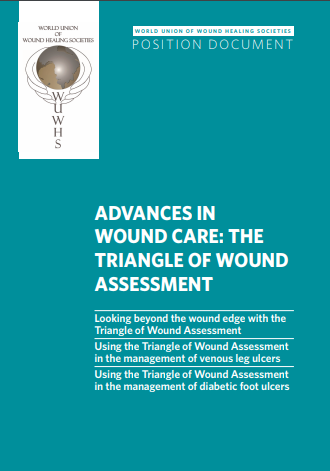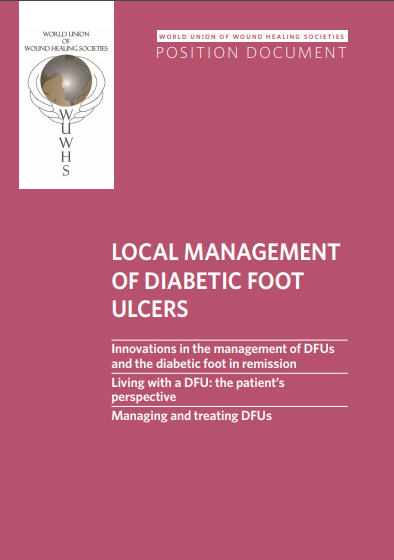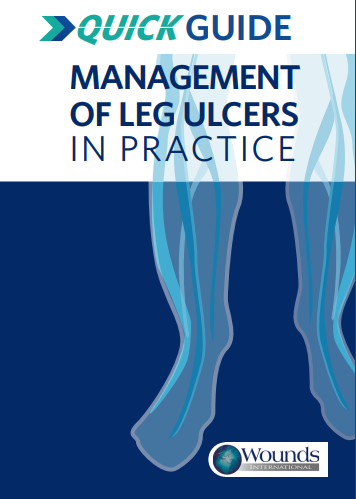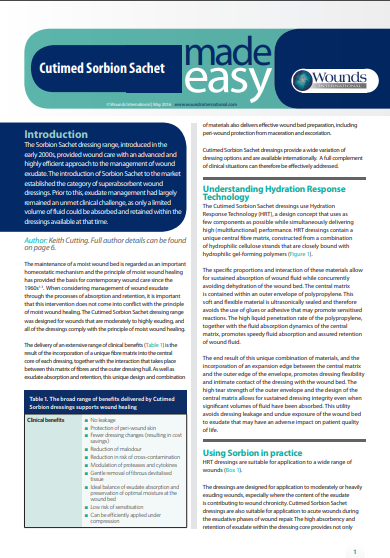Photobiomodulation with LumiHeal™ Made Easy

This Made Easy introduces LumiHeal, a novel photobiomodulation (PBM) treatment that incorporates an LED lamp and photoconverter gel. New studies indicate that PBM may be particularly useful in the treatment of chronic wounds, positively affecting all stages of the wound healing process and improving healing rates. Supported by Klox Technologies
Patient story: wound treatment success with a homemade dilute hypochlorous acid solution
<p class="p1">My mother Alice suffered for more than 3 years with chronic leg ulcers which, although shallow, covered up to half of her lower right leg. After trialling many different dressing regimens without healing the wound, our final path to success used a homemade dilute hypochlorous acid solution to soak and clean the wound on […]
Wound assessment: exudate
<p class="p1">Wound assessment is a skill that is an essential part of successful wound care. Information gained from wound assessment is used to decide what stage of healing the wound is at, whether it is progressing or deteriorating, and whether the treatment plan is appropriate or not. Documenting this information is an essential part of […]
Use of bismuth in wound care: review and case report
<p class="p1">Compounds containing bismuth have antimicrobial properties and have been used for many years in healthcare in various forms, including in the management of wounds to protect against and to treat infection. By describing the mode of action and usage of bismuth-containing dressings in wound care, this article aims to raise awareness of their role […]
The use of a novel antimicrobial and purified native collagen matrix combination to manage bioburden and support healing in challenging wounds: a clinical evaluation
<p class="p1">Biofilm is present on the vast majority of chronic wounds and is suggested to be a key factor contributing to impaired healing. Biofilm provokes a heightened and prolonged inflammatory response with excessive proteolytic enzymes that degrade newly formed extracellular matrix and delay the healing process[2,3]. Biofilms are challenging to treat thanks to their innate survival […]
Wounds digest 7(3)
<p class="p1">In this section, a brief synopsis is presented of a range of recently published articles that may be of interest to health professionals working in the wound care setting. The aim of this round-up is to provide an overview, rather than a detailed summary and critique, of the research papers selected. Full references are […]
World Union of Wound Healing Societies — educational documents available to all
<p class="p1">As <em>Wounds International </em>goes to press for this month’s edition, the 2016 Olympic and Paralympic Games in Rio de Janerio have drawn to a close. While the athletes will take a well-earned rest, it will not be long before the lessons learned, the medals won and the huge inspiration that emerges from such a […]
Clinical innovations: lymphoedema management
<p class="p1">With regards to recent advances in imaging and surgical approaches, what is new in the lymphoedema world? What has been proven through clinical trials and which of this evidence/information is translatable into clinical practice? What needs to be done and what seems to work in the clinic, but does not have solid evidence behind […]
Consensus document: Closed surgical incision management: Understanding the role of NPWT

Substantial numbers of patients develop surgical site infections and other incisional complications worldwide each year. The social, healthcare and wider economic implications are considerable. As the average age of the population increases and multi-morbidity becomes more common, the number and complexity of surgical procedures performed is rising. As a result, reducing the risk and burden […]
Position document: Management of biofilm

Antimicrobial and multi-drug resistance loom large on the global healthcare landscape, in particular in the treatment of chronic, hard-toheal wounds where current figures put the presence of biofilm in 60%–100% of non-healing wounds. While the role that biofilm play in the chronicity of wounds is still in infancy, it is becoming widely accepted that hard-to-heal […]
Position document: Advances in wound care: the triangle of wound assessment

Wound assessment is complex and requires a range of clinical skills and knowledge. It has never been more important to challenge current assessment paradigms and extend our understanding of wound assessment beyond the wound edge. Supported by Coloplast
Position document: Local management of diabetic foot ulcers

Incidence of diabetes among the world’s adult population has almost quadrupled in the past 30 years with 422 million adults worldwide now diagnosed with the disease, according to the 2016 World Health Organization Global Diabetes Report. Within this population, the incidence of diabetic foot ulcers (DFUs) is reported to be 4%–10%, with a 1-in-4 risk […]
Position document: Understanding hidradenitis suppurativa

Consensus document: Role of dressings in pressure ulcer prevention

Recognition of the huge economic, health-related and social burden of pressure ulcers has resulted in considerable efforts to reduce their occurrence. Despite this, pressure ulcers still occur. In recent years, evidence has been building that some types of dressings typically used to treat open wounds have the potential to supplement standard pressure ulcer prevention measures […]
Ten top tips: the legalities of pressure ulcers
<p class="p1">When it comes to medical malpractice lawsuits, a large number of them are brought to lawyers as a result of the patient and/or the patient’s family being frustrated or angry about an unexpected event or outcome occurring in relation to his/her medical treatment. This should come as no surprise as it is human nature […]
Clinical innovation: Treatment with an anti-scar gel and massage ball improves physical parameters of hypertrophic scars
<p class="p1">Silicone gels are currently considered the gold standard, first-line, non-invasive prevention and treatment for hypertrophic scars. Although their mode of action is not yet fully understood, scar hydration seems to play a key role. This article outlines the findings of a pilot, single-centre, single-group, open-label evaluation of Bepanthen® Anti-Scar Gel and Massage Ball in […]
Clinical report: Innovations in hard-to-heal wounds WUWHS

A well-established practical and predictive measure of complete wound healing over the longer term (24 weeks) is per cent change in wound area over the first 4 weeks. However, certain conditions have the potential to delay healing and signs may indicate stalled healing: infection, ischaemia, or abnormal inflammation, with impaired inflammatory response often being self-perpetuating. […]
Cutimed HydroControl Made Easy

Promoting healing in dry/low-exuding and sloughy wounds, which may be failing to progress as expected, can be challenging. This Made Easy will focus on how to manage these challenges, how dressing technologies can help to help to promote healing and introduce Cutimed® HydroControl dressings (BSN medical), which are designed to promote healing in such wounds. […]
How can we know the true magnitude of any breast cancer-related lymphoedema if we do not know which is the true dominant arm?
<p class="p1"> <strong>Background: </strong>Patients with breast cancer tend to limit the use of their arm which may result in muscle reduction and misdiagnosis of breast cancer-related lymphoedema (BCRL). <strong>Aims: </strong>To examine whether patient-reported arm dominance matched the true dominant arm and if the side of surgery had an impact on grip strength and BCRL. <strong>Methods</strong>: Grip […]
Novel body-weight device for compression garment donning in lymphoedema treatment
<p class="p1"><strong>Background: </strong>Lymphoedema is commonly treated using complex decongestive therapy followed by the application of compression garments. These elastic garments are often difficult to pull over the enlarged limb. <strong>Aim: </strong>To design and build a novel device to assist with the donning of compression garments in a clinic and assess its use in practice. <strong>Method: […]
Wider collaboration on lymphoedema research is needed: footwear and gait analysis
<p class="p1">Extending teams researching and managing lymphoedema to include orthotists and podiatrists may extend our understanding of the condition and component parts of treatment. New technology, some of which is low cost, enables an increasing range of data and outcome measures. This article highlights the reality of a shortage of studies involving gait analysis and […]
Sodium valproate as a cause of unilateral pitting lower-limb oedema mimicking lymphoedema in a child
<p class="p1">This case study deals with a 7-year-old boy who developed unilateral, lower-limb pitting oedema that was determined to be a complication of long-term sodium valproate use. The diagnosis was complicated by the fact that the child had previously resided in an area known to harbour the pathogens causing filariasis and by the fact that […]
Matts’ hypothesis: how simple strategies can lead to better outcomes
<p class="p1">This article looks at the causes of oedema, lymphoedema and conditions such as lymphatic filariasis and podoconiosis – and how the treatment of leg swelling has changed over the years. It highlights Matts’ hypothesis (reported for the first time herein), which suggests that lymphoedema can be caused by a breakdown of the stratum corneum’s […]
Use of the HIVAMAT® 200 with manual lymphatic drainage in the management of lower-limb lymphoedema and lipoedema
<p class="p1"><strong>Background: </strong>Manual lymphatic drainage (MLD) is a well-recognised and traditional treatment modality for oedema. HIVAMAT<sup>®</sup> 200 is a novel device that uses an intermittent electrostatic field to stimulate blood and lymphatic flow, thereby reducing oedema. This study aims to compare the effects of MLD alone to HIVAMAT<sup>®</sup> 200 plus MLD. <strong>Method: </strong>Three females with […]
The story of my legs — a long and winding road to a good outcome
<p class="p1">When I was younger, for many years I suffered all kinds of illnesses, including pneumonia, scarlet fever, diphtheria, mumps and tonsillitis. I never went to hospital — my mum cared for me at home. I think that is why my lymph nodes worked overtime; you can’t keep working at 100% all the time without […]
Links between BMI and the increasing incidence/prevalence of chronic oedema: what is our future?
<p class="p1"><span class="s2">T</span>here are five important points of note. Firstly, the prominence and importance of the lymphatic system has been elevated with the knowledge that it is the only path by which all that leaks out of the vascular system is returned to it. Secondly, we are facing a potentially massive epidemic of chronic oedema […]
Abstracts from the 6th International Lymphoedema Framework Conference
<p class="p1"> The 2016 Asia Pacific Lymphology Conference is a product of a collaboration between the International Lymphoedema Framework and the Australasian Lymphology Association. It brings together delegates (including patients) from around the world, but with a focus on those from developed and developing nations from the Asia-Pacific region. The aim of the conference is to […]
Does measuring blood pressure post-breast cancer surgical intervention increase the risk of developing ipsilateral arm lymphoedema?
<p class="p1">Despite advances in our medical and surgical treatment modalities, and earlier detection, breast cancer surgery and/or radiotherapy remain the most common causes of secondary lymphoedema. Lymphoedema in the same arm that was exposed to the surgery/radiotherapy is referred to as breast cancer-related lymphoedema (BCRL). To date, the link between transiently compressing the at-risk arm […]
Perceived barriers to adherence to breast cancer-related lymphoedema self-management
<p class="p1"><strong>Background: </strong>Self-management is critical for the effective maintenance of breast-cancer related lymphoedema (BCRL), but levels of adherence are suboptimal. <strong>Aims: </strong>To compare the perceptions of lymphoedema therapists with those of women affected with BCRL regarding barriers to self-management. <strong>Methods: </strong>One-hundred-and-sixty-two women with breast cancer-related lymphoedema and 98 lymphoedema therapists were recruited. Participants completed an […]
TIELLE™ Hydropolymer foam dressings in practice

This case study booklet describes the use of TIELLE Silicone Border and TIELLE Non Adhesive in the management of a variety of chronic wounds and in patients with complicating factors. Many of the patients were experiencing acute, high levels of wound-related pain, exudate levels and decreased quality of life as a result of both the […]
Patient involvement in wound care: a platform for change: Part 1

In this webcast, Professor Zena Moore, focuses on the increasing importance of patient involvement in managing the burden of wound care and maintaining the sustainability of our healthcare systems In the first presentation, Christine Moffat, Professor of Clinical Nursing Research at the University of Nottingham (UK), explores ways to encourage patient involvement, looking at how […]
Patient involvement in wound care: a platform for change: Part 2

In this webcast, Professor Zena Moore, focuses on the increasing importance of patient involvement in managing the burden of wound care and maintaining the sustainability of our healthcare systems In the first presentation, Christine Moffat, Professor of Clinical Nursing Research at the University of Nottingham (UK), explores ways to encourage patient involvement, looking at how […]
Patient involvement in wound care: a platform for change: Part 3

In this webcast, Professor Zena Moore, focuses on the increasing importance of patient involvement in managing the burden of wound care and maintaining the sustainability of our healthcare systems In the first presentation, Christine Moffat, Professor of Clinical Nursing Research at the University of Nottingham (UK), explores ways to encourage patient involvement, looking at how […]
A reliability study of wound assessment tools for diabetic patients in Indonesia
<p>Wound assessment tools specifically for diabetic foot wounds are less well developed than those for wounds such as pressure ulcers. The aim of this study was to evaluate the inter-rater reliability of a new wound assessment tool developed for diabetic foot wounds in Indonesia. The results showed that the inter-rater reliability of the MUNGS (maceration, […]
The economic impact of hard-to-heal wounds: promoting practice change to address passivity in wound management
<p>As the prevalence and incidence of wounds are predicted to increase due to an ageing population with increasing comorbidities, reducing the burden of wounds by optimising healing is seen as a key factor in lowering wound care costs. Inappropriate or delayed treatment adversely affects the time to wound healing, impacting quality of life, and increasing the […]
Top tips: gun shot wounds
<p>Trauma is the number one cause of mortality in Americans under the age of 45 and the fifth most common cause of death overall. <br />Traumatic injuries are categorised as blunt or penetrating for the purpose of triage. Penetrating injuries result in a much higher injury severity. On arrival at the hospital, patients with a penetrating […]
Mepilex XT in practice: results of a study in German specialist wound care centres
<p>Effective exudate management has been shown to reduce time to healing, reduce the risk of skin damage and infection, enhance patient quality of life and improve healthcare efficiency. While not all exudate is necessarily ‘bad’, it is vital that clinicians aim to find a balance between the beneficial and damaging effects of exudate in order to achieve […]
Patient story: the story of my legs — a long and winding road to a good outcome
<p>In this article, the author describes his experience living with lymphoedema, outlining the difficulties he has encountered and the treatment and management strategies that have been employed over the years.</p>
Successful management of a non-healing foot wound using a bacteria and fungi binding dressing
<p>This case report describes the treatment of a non-healing traumatic foot wound in an older patient with the concurrent issue of a hip fracture. The wound had previously been managed with antibiotics, silver ointment and protective dressings. The presence of superficial tissue necrosis continued to increase the infection risk and forefoot amputation was proposed. Amputation […]
Improving patient quality of life using a new foam dressing in a wound of 3 years’ duration with multiple comorbidities
<p>This case report describes the use of TIELLE™ Silicone Border in the management of a chronic venous leg ulcer of 3 years’ duration, in a patient with multiple relevant comorbidities. Despite several, ongoing prior interventions, the wound remained unhealed, and continued to present issues related to exudate levels and maceration. During the dressing evaluation period, […]
Wounds digest 7(2)
<p>In this section, a brief synopsis is presented of a range of recently published articles that may be of interest to health professionals working in the wound care setting. The aim of this round-up is to provide an overview, rather than a detailed summary and critique, of the research papers selected. Full references are provided […]
Wounds — not just a hole in the patient
<p>For the second successive year, Wounds International — the online, quarterly page-turning journal — and its sister publication Wounds UK, have combined content to form a special, printed ‘hybrid’ issue. This will be available to delegates attending the European Wound Management Association (EWMA) 2016 conference, which is to be held in Bremen, Germany. The theme of this […]
Quick Guide: Management of Leg Ulcers in Practice

This Quick Guide outlines the management of leg ulcers, with a focus on: assessment and diagnosis, best practice wound and skin management, and compression therapy where suitable. Supported by B Braun
Using collagen dressings in non-healing wounds Quick Guide

Multiple factors may result in a wound failing to heal according to a normal trajectory. This Quick Guide looks at using collagen to restart the healing process, the important roles collagen dressings play in tissue repair, and ultimately, how collagen can help a wound re-epithelialise and move towards closure. Supported by KCI – An Acelity […]
Cutimed Sorbion Sachet Made Easy

Outlining the patient and practitioner benefits of the Cutimed Sorbion Sachet dressing range and its Hydration Response Technology, with tips for use and a guide to when the dressings can be used. Supported by BSN Medical / Essity
Managing peristomal skin complications Quick Guide

Unlike wounds, where the ultimate treatment goal is healing, stomas are a breach of the skin that are designed to stay open in order to drain the stoma effluents. Therefore the surrounding skin requires scrupulous care to maintain its health and avoid dermatological complications. This Quick Guide outlines common peristomal skin complications and how they […]
A new year, a new document: patient involvement now a priority
<p>It is recognised and accepted that for the sustainability of healthcare systems worldwide, some things need to change and that if patients are involved in making decisions and managing aspects of their own care, there will be improved outcomes for all and less strain on resources. With this goal in mind, an international group of nine […]
Clinical innovation: knee flexion contracture as an independant risk factor for the development of heel pressure ulcers
<p>Heels are the second most common anatomical location for pressure ulcers. The prevalence rate of visible heel pressure ulcers varies from 7.3% in a small sample[2] to 18.2% in a large sample. The anatomic location of suspected deep tissue injury is more commonly seen on the heel (41%) compared to the sacrum region (19%) or […]
Dressings and biofilms: interpreting evidence from in vitro biofilm models
<p>In vitro models are used to study biofilm behaviour. However, the model and assay conditions can substantially affect results. This review discusses published in vitro biofilm models used to evaluate antimicrobial wound dressings, identifying variables that may affect outcomes. Many biofilm models mimic specific clinical conditions, which may explain conflicting data. Understanding the relationship between […]
Why don’t wounds heal?
<p>The healing of a wound is achieved by way of the integrated phases of haemostasis, inflammation, proliferation, and remodelling, which must occur in the proper sequencing and time period, without interference and at an optimal intensity, in order for a wound to heal normally.</p>


